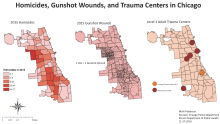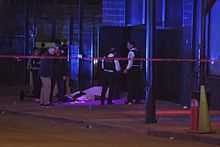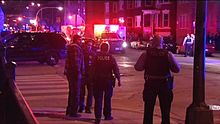Crime in Chicago
From Wikipedia, the free encyclopedia
| Chicago | |
|---|---|
| Crime rates* (2016) | |
| Violent crimes | |
| Homicide | 20.88 |
| Forcible rape | 52.4** |
| Robbery | 353.6 |
| Aggravated assault | 480.2 |
| Total violent crime | 903.8 |
| Property crimes | |
| Burglary | 481.9 |
| Larceny-theft | 2089.7 |
| Motor vehicle theft | 374.6 |
| Arson | 16.9 |
| Total property crime | 2946.2 |
Notes
*Number of reported crimes per 100,000 population.
** Revised definition[1]
Source: [[2][3] ] | |
Crime in Chicago has been tracked by the Chicago Police Department's Bureau of Records since the beginning of the 20th century. The city's overall crime rate, especially the violent crime rate, is substantially higher than the US average. Chicago was responsible for nearly half of 2016's increase in homicides in the US, though national crime rates stay near historic lows.[4][5][6]
Contents
[hide]Overview[edit]
Chicago saw a major rise in violent crime starting in the late 1960s. Murders in the city first peaked in 1974, with 970 murders when the city's population was over three million, resulting in a murder rate of around 29 per 100,000, and again in 1992, with 943 murders when the city had fewer than three million people, resulting in a murder rate of 34 murders per 100,000 citizens.
After 1992, the murder count decreased to 641 murders. The population was 2,799,000 in 1999, so the reduction was slow, but still an improvement. In 2002, Chicago had fewer murders but a significantly higher murder rate than New York or Los Angeles.[7]
Violent crime[edit]
Chicago experienced a major rise in violent crime starting in the late 1960s,[8] a decline in overall crime in the 2000s,[9] and then a rebound in overall murders the mid-2010s.[10] Murder, rape, and robbery are common violent crimes in the city, and the occurrences of such incidents are documented by the Chicago Police Department and indexed in annual crime reports.[11]
After adopting crime-fighting techniques in 2004 that were recommended by the Los Angeles Police Department and the New York City Police Department,[12] Chicago recorded 448 homicides, the lowest total since 1965. This murder rate of 15.65 per 100,000 population is still above the U.S. average, an average which takes in many small towns and suburbs.[13]
Chicago's homicide rate had surpassed that of Los Angeles by 2010 (16.02 per 100,000), and was more than twice that of New York City (7.0 per 100,000) in the same year.[14] By the end of 2015, Chicago's homicide rate would rise to 18.6 per 100,000. By 2016, Chicago had recorded more homicides and shooting victims than New York City and Los Angeles combined.[15]Chicago's biggest criminal justice challenges have not changed much over the last 50 years, and statistically reside with homicide, armed robbery, gang violence, and aggravated battery. On March 27 of 2016, Mayor Rahm Emanuel appointed former CPD Chief of Patrol, Eddie Johnson, as the new police superintendent, who was confirmed by a unanimous vote of the Chicago City Council in April 2016. He replaced interim superintendent, John Escalante.[16][17]
Murder and shootings[edit]
According to the 2011 Homicide Report released by the Chicago Police Department, the murder clearance rate has dropped from over 70% for 1991 to under 34% for 2011. Former Chicago Police Supt. Garry McCarthy said a pervasive "no-snitch code" on the street remains the biggest reason more murders aren’t being solved in Chicago, adding, "We’re not doing well because we’re not getting cooperation".[18] By 2016, Chicago's murder clearance rate had dropped to only 21%, and its detective force had dwindled from 1,151 in 2009 to 863 as of July 2016.[19][20] A Chicago Magazine article further pointed out that, "in Chicago, people are quite literally getting away with murder".[21] 76.3 percent of murder victims had a prior arrest history. Warmer months have significantly higher murder rates, and over 70% of murders take place between 7PM and 5AM.[22][23]
In 2011, 83% of murders involved a firearm, and 6.4% were the result of a stabbing. 10% of murders in 2011 were the result of an armed robbery and at least 60% were gang or gang narcotics altercations. Over 40% of victims and 60% of offenders were between the ages of 17 and 25. 90.1% of victims were male. 75.3% of victims and 70.5% of offenders were African American, 18.9% were Hispanic (20.3% of offenders), and 5.6% were white (3.5% of offenders).[22]
Murder rates in Chicago vary greatly depending on the neighborhood in question. Many neighborhoods on the South Side tend to be poorer, less educated, predominantly African American, and infested with street gangs.[24] The neighborhoods of Englewood on the South Side, and Austin on the West side, for example, have homicide rates that are 10 times higher than other parts of the city.[25] Violence in these neighborhoods has had a detrimental impact on the academic performance of children in schools, as well as a higher financial burden for school districts in need of counselors, social workers, and psychiatrists to help children cope with the violence.[26] In 2014, Chicago Public Schools adopted the "Safe Passage Route" program to place unarmed volunteers, police officers and firefighters along designated walking routes to provide security for children en route to school.[27] From 2010-2014, 114 school children were murdered in Chicago.[28]
2015 saw an increase in homicides and shooting incidents compared to 2014. In October, over 18 area alderman called for Mayor Rahm Emannuel to dismiss Chicago Police Superintendent Garry McCarthy citing a 21% increase in murders and shootings in 2015.[29] Also in October 2015, Jesse Jackson's Operation PUSH called for President Obama to declare a state of emergency in Chicago over gun violence. McCarthy was later terminated by Emanuel following the fall out from the shooting of Laquan McDonald.[30][31] In 2015, Chicago recorded 2,987 shooting victims and 488 homicides.[32][33]
A gunshot wound to center mass can quickly prove fatal without immediate medical attention due to blood loss and Internal injuries.[34] Chicago emergency responders and ER doctors have been praised for their ability to keep the vast majority of shooting victims alive.[35] In September 2015, University of Chicago Medicine and Sinai Health Systems announced a joint 40 million dollar venture to convert Holy Cross Hospital into a level 1 trauma center on the South side, making some of Chicago's most violent neighborhoods less than 5 miles from high quality care.[36] Non-fatal gunshot victims in Chicago had an overall rate of occurrence of 46.5 per 100,000 from 2006-2012, with a demographic breakdown of 1.62 per 100,000 for whites; 28.72 for Hispanics, and 112.83 for blacks.[37] It is estimated that the medical expenses associated with gun violence costs the city of Chicago 2.5 billion dollars a year.[38][39]
Chicago has been criticized for comparatively light sentencing guidelines for those found illegally in possession of a firearm. Most people convicted of illegal gun possession receive the minimum sentence, one year, a Chicago Sun-Times analysis found, and serve less than half of the sentence because of time for good behavior and pre-trial confinement. The minimum sentence for felons found in possession of a firearm is 2 years. Those charged with simple gun possession had an average of four prior arrests. Those charged with gun possession by a felon had an average of 10 prior arrests. Mayor Rahm Emanuel has unsuccessfully pushed the Illinois General Assembly for tougher sentencing guidelines for gun possession. Legislation was opposed by African American legislators who felt it would unfairly target blacks, and also the NRA, who felt that law-abiding, first time offenders would be unjustly caught in the same criminal net as gang members.[40]
In July 2015, Chicago recorded a grisly and still unsolved quadruple homicide in the Chatham neighborhood which left a single mother and her 3 children all dead.[41] In October 2015, Chicago was named "America's mass shooting capital", citing 18 occasions in 2015 in which 4 or more people were shot in a single incident. By October 2016, Chicago had already recorded 28 mass shooting incidents for the year, resulting in 12 fatalities and dozens injured. 2016's largest mass shooting event took place on October 15. A shooter in Chicago's Garfield Park neighborhood on Chicago's West side opened fire on a group of people from a passing vehicle killing one and injuring 6 others.[42][43][44][45][46]
2016 began as the bloodiest initial quarter of a year in Chicago in decades. More than 100 people were shot just within the first 10 days of the year.[47] By the end of March, the murder rate in Chicago had soared 72% compared to the same time frame in 2015, leaving 345 people murdered. Shooting victims that managed to survive their injuries also saw a sharp increase of 88 percent compared to 2015, leaving 676 people with gunshot wounds.[48] In the FBI's preliminary 2015 UCR (Uniform Crime Report) covering the first half of 2015, it noted an 18.29% increase in murders compared to 2014's data.[49] The end of Memorial Day weekend closed out the bloodiest May in Chicago in over 2 decades, leaving 66 murdered and nearly 400 shot.[50] The Labor Day holiday weekend of in Chicago also tallied 13 killed, with another 52 injured from gunfire.[51] Chicago recorded over 876 people shot over 4 July weekend.[52][53] Arthur Lurigio, a professor of criminal justice and psychology at Loyola University, called the escalating violence "alarming", further commenting that "we have to go back decades to find jumps of this magnitude in year-to-year comparisons. We're on our way to 500 homicides again. We're going backward."[54]
August 2016 marked the most violent month Chicago had recorded in over two decades with 92 murders, included the murder of Nykea Aldridge, cousin of NBA star Dwyane Wade.[15][55] By September 2016, Chicago had reached 500 people murdered and 3,000 people shot, surpassing totals for all of 2015 in just 9 months.[56][57]By October 2016, Chicago had surpassed 600 homicides and over 2,800 people shot, marking a 32 percent increase in murders and non-fatal shootings compared to 2015. October 2016 was the second deadliest month in 2016 with 78 homicides; more than double the 31 homicides of October 2015. On December 1, 2016, Chicago recorded it's 700th homicide for the year.[58] [59] Chicago's 2016 murder and shooting surge has attracted national media attention from CNN, The New York Times, USA Today, Time Magazine and PBS.[48][60][61][62][63] Filmmaker Spike Lee's 2015 release, Chi-Raq, highlights Chicago's gun violence using a narrative inspired by the Greek comedy Lysistrata.[64]




No comments:
Post a Comment